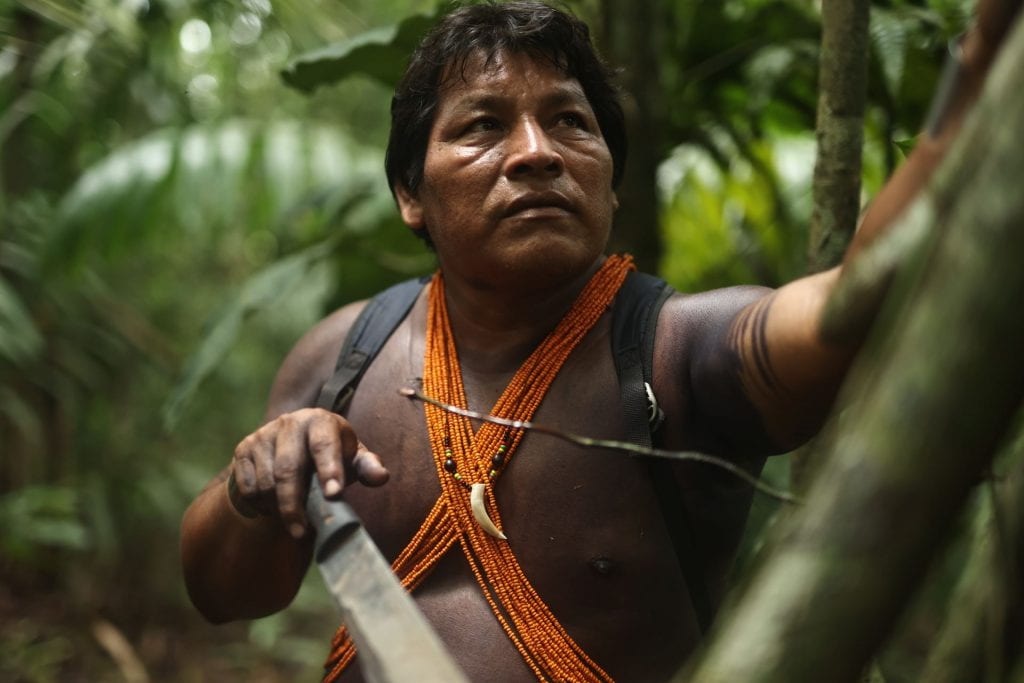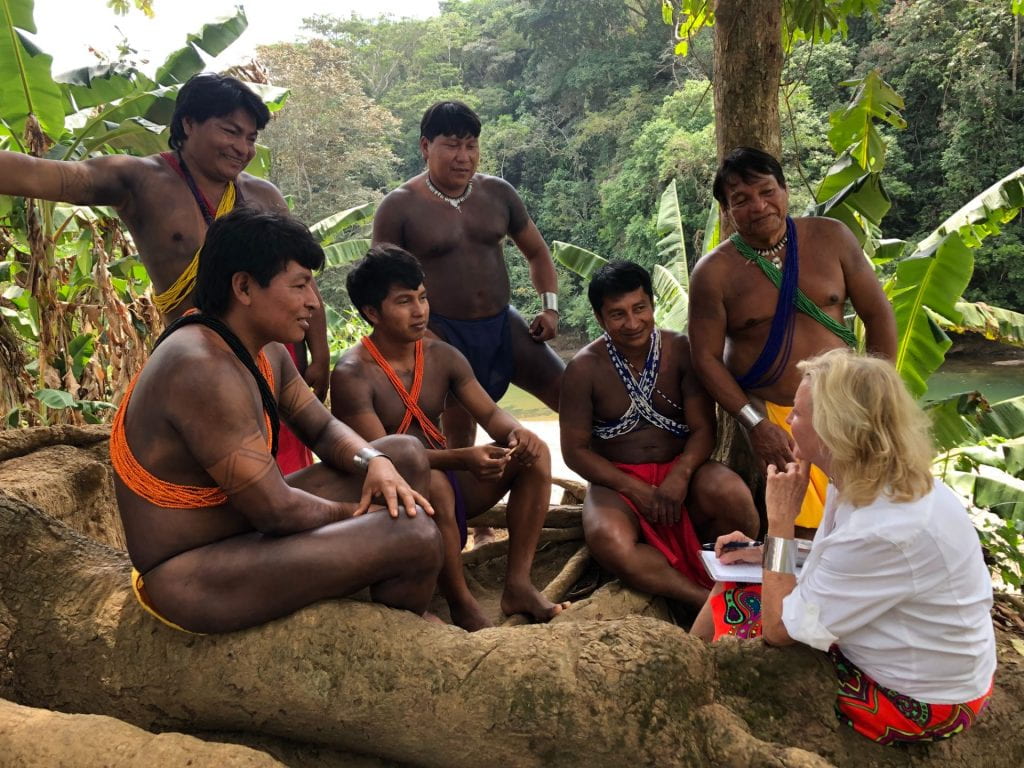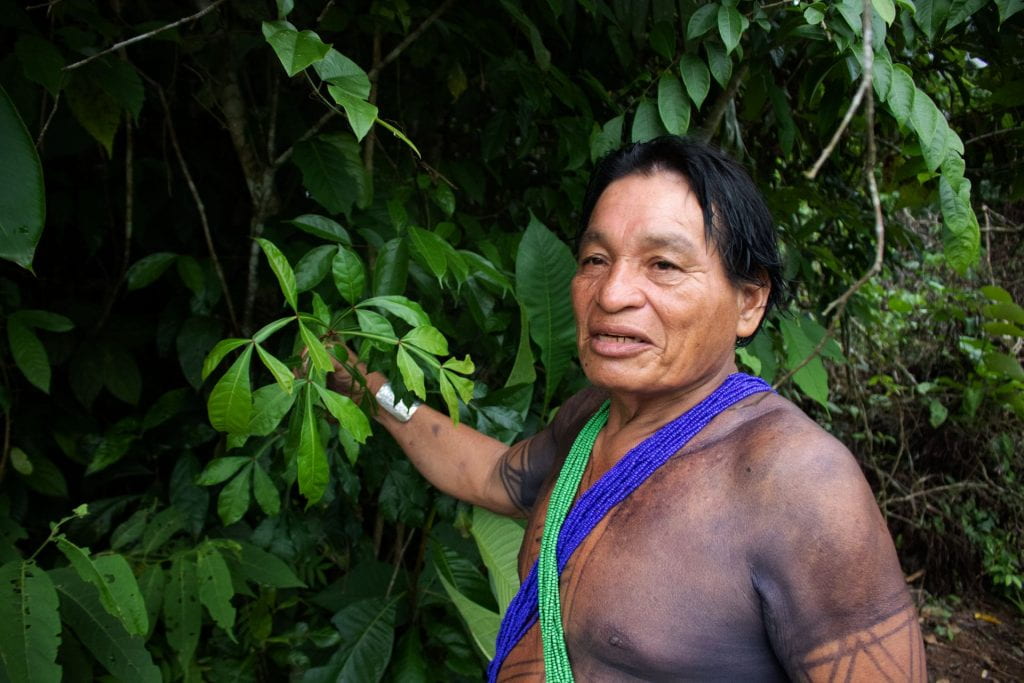Emberá villagers straddle western and traditional medicine
By Kenneal Patterson

EMBERÁ PURÚ, Panama — It was the middle of the night when Estenilao Barrigón and his wife, Mary, quietly boarded a piragua, or wooden canoe, on the edge of the Rio Pequení. Guided mostly by moonlight, the 3 a.m. voyage would take them to a road near Panama’s Chagres National Park. It would be a long, arduous trip, one that would involve paddling over shallow waters and navigating erratic currents. But little could deter them – especially when Mary’s cancer treatment waited at the journey’s end.
Sometime later that morning, Barrigón returned to the rest of his family, who live in the isolated Emberá community. The village is bordered by thick jungle forests and a snaking river – a highway of travel for several indigenous villages with no way in and out other than a jungle trek and canoe trip. Emberá people like Barrigón depend on this haven of biodiversity for their medicine: roots, leaves and tree trunks are ingredients for treatments for anything from common coughs to dizziness. But he also heads to the outside world for chemotherapy to treat his wife’s gastrointestinal cancer.
“I always tell her everything is going to be OK,” said Estenilao in a late May interview, translated from Spanish. Mary, 32, and mother to his three children, is his second wife; his first wife and mother to his son Brody, 8, died from the same cancer.
As it is for this indigenous couple, Western medicine and traditional Emberá treatments are slowly starting to mix. When children have a stomachache, they’re given a steaming cup of leaf-infused tea. But, many are also taken into the city for routine vaccinations. Some may chew a plant called “burumia,” commonly found in forest undergrowth, whose long stringy roots can numb the mouth for dental procedures performed in the jungle. But others will make the hours-long journey to visit Panamanian doctors to treat infections or for stitches.
Many Emberá people are grateful for access to both reserves of knowledge, but others worry that community members are forgetting their identity.
In the last 300 years, several regimes have sought to stamp out traditional Emberá culture. This intrusion started in the late 1700s, when Spanish colonialists forced the Emberá to migrate from Colombia to remote jungles in Panama. Many took refuge along the banks of freshwater rivers that wind through the narrow isthmus. Throughout the 20th century, several missionaries visited the communities, seeking to convert the tribes to Christianity. Further changes took place in the 1960s when Omar Torrijos Herrera, the commander of the Panamanian National Guard, urged the indigenous communities to desert their isolated territories and integrate with the rest of the population. After Herrera died in 1981, the Panamanian government began to exploit natural resources for financial gain, violating Emberá land and leading many to assimilate with Western society.
But not all of them left. Around 4,000 still reside in isolated tribal territories, from the dense forests of the Darién region to the waterways east of Colón.
There, in a town of 130 people resting on a remote embankment, lives Barrigón and his family.
The village is small yet lively. Thatched palm huts, raised on stilts, overlook the Emberá community’s life source: a river rich with fish. The dirt-covered clearing, where homes dot the raised bank, buzz with the laughter of Emberá children and squawking of village chickens. The kitchen rests at the heart of the community: an open air, raised platform bearing a fireplace and dishware. During mealtimes, fires blaze beneath steaming pots of rice and fried plantains. The Emberá women, adorned with silver cuffs and dressed in floral skirts, tend to the flame.

After school, children play, running barefoot across winding dirt or muddied paths. The jungle creeps in from all sides, sprouting hibiscus bushes and dangling vines, beckoning from the village edge.
But as vibrant as it is, Barrigón’s community is at risk. It’s happened to others – all across the Americas, hundreds of indigenous tribes have been diminished or eradicated, a tension that is stark and well-documented. Emberá land rights are threatened by a government that fails to recognize their autonomy and property. The Panama Canal Authority partly manages the land on which they reside, and so their traditional practices are restricted, including cutting trees for wood or medicine. There’s also little curriculum in place to educate young people about the country’s indigenous history, traditions and systems.
“The government wants our culture to disappear,” said Ruben Barrigón, Estenilao’s brother, in an interview translated from Spanish. He knows that many indigenous communities have already faded to distant memories. He fears they will be next.

Medicine in suitcases
Ruben Barrigón is a “hainbane,” the Emberá term for doctor. He knows ancient cures, passed down from his father and grandfather – an expertise that few in the communities possess. Wearing a red loincloth tied around his waist and an orange beaded necklace that crisscrosses against his neck and chest, he trudges in rubber boots through the jungle, wielding a machete, digging up roots, plucking leaves and collecting wild herbs for his patients.
He’s also training to be a paramedic.
He’s one of a handful of indigenous Panamanians working with a Christian-affiliated U.S. non-profit called Panama Missions. He moves from community to community: some days are spent helping his own village, and on others he travels hours to the Darién Province close to Colombia, where the densest rain forests are and the furthest reaches of the Emberá live. There, he’ll treat dozens of people with medication provided by Mission Panama, as well as perform surgeries to remove masses, stitch up wounds and treat infected skin lesions. If someone asks, he’ll also administer traditional Emberá cures.
Diane Edrington, the medical director of Alabama-based Panama Missions, has been working with indigenous communities in the Darién Province for 22 years; she’s also studied tropical diseases at the Alexander von Humboldt Tropical Medicine Institute in Lima, Peru. “This has become my passion,” says Edrington. “These groups don’t have access to healthcare as people do in the city… and they’re very open to our medicine.”
It’s taken decades for the organization to get where it is today, Edrington says, but now they work closely with the Ministry of Health and Lorena Castillo García de Varela, Panama’s first lady, to carry medicine in heavy suitcases biannually into Panama. It’s not easy. Edrington is faced with stacks of paperwork and routine meetings before she’s allowed to bring supplies across the border. And once she arrives, it can take her three hours by boat to reach just one village. There are over 40 in Darién alone.
Edrington doesn’t fear the demanding journey. It brings her closer to the communities in more ways than one. “There’s so much we can learn from them,” she says. “I’m always trying to learn more about tropical medicine and the things they use.”
But not all doctors understand or even respect Emberá medicine, as Edrington does. Many point to the fact that proof of its efficacy is anecdotal, with no empirical research to back it up.
Some maintain that natural remedies can be ineffective or possibly dangerous. When the World Health Organization, in 2019, included a Traditional Chinese Medicine chapter in its famous global compendium, scientists across the world were outraged, and Scientific American Magazine called the move “an egregious lapse in evidence-based thinking and practice.”
This has created a divide between many doctors and their patients in areas where indigenous culture persists. In 2020, a study in the American Medical Association Journal of Ethics noted that mainstream doctors rarely learn about traditional Native American healing or history, for example, leading to incongruent practices between the two communities.
Yet Ruben Barrigón subscribes to both beliefs. He thinks that around 40% of Western medicine is accurate, and expresses thankfulness over developments like anesthesia, which keeps his patients subdued. Emberá botanic medicine is more trustworthy, he says, and maintains that around 80% of it is effective.
Endlessly skeptical and hopeful, he scrutinizes each tradition to ensure the best for his practice and his people. “It’s my project to keep my community in good health,” he says.

Two worlds converging
In a world of real-time notifications and endless posting on social media, the concept of orally shared knowledge seems archaic. But Barrión didn’t learn botany through books or courses taken at medical school. He learned it from his father and his grandfather before him: sacred teachings passed on by story and practice through the generations.
These village healers are custodians and loyal sentinels, defending this precious knowledge. But it may not be enough. The outside world has crept into the Emberá homeland, and many young people are infected with dreams of city life. Dozens are flocking to metropolises, leaving behind their refuge for a new kind of jungle made of concrete.
There have been several efforts to defend the traditions of the Emberá from the encroachment of the West. In 2016, the Panamanian government created Law 17, which officially established the protection of indigenous medicine. The law established 10 goals including revitalizing indigenous systems, promoting botanical medicine under conditions of safety and quality and recognizing the traditional training of indigenous doctors.
The importance of this preservation has been further backed by a number of scientific studies including research from the University of Antioquia in Colombia that examined Emberá people living in that country. Headed by Jaiberth Anotonio Cardona-Arias, it looked at the deep connection between Emberá healing and Mother Nature, as well as the spiritual dimension of the practices.
Cardona-Arias concedes that the efficacy of Emberá medicine is up for debate, and that even Emberá healers recommend heading to city hospitals for life-threatening ailments. Nevertheless, in its English translation, the study shows that Emberá practices “make visible the benefits of indigenous medicine, prepare health services to tolerate cultural differences, understand how the two medical systems can communicate, organize intercultural health services, consolidate medical research traditional, increase the level of information and use of traditional medicine, and rescue and systematize knowledge about traditional medicine as part of our culture.”
But resistance to western medicine can’t just be pinned to cultural differences. Many indigenous communities lack the infrastructure to support allopathic practices. The communities are hard to reach and hard to leave, often separated by miles of thick rainforest. An absence of health education makes it hard to even diagnose illnesses. And many indigenous people can’t pay an expensive hospital bill, let alone effectively communicate their needs due to language barriers, as most communities have their own distinct tongues.
The COVID-19 pandemic complicated matters, even though only one person died in the Emberá Purú community: a man in his late 70s. In order to prevent the virus’s spread, the Panama Ministry of Health implemented several protective measures without the consultation of the communities. In early 2020, there were few efforts to inform the indigenous communities or take their insight into account. Additionally, few indigenous leaders were elected to national COVID health committees to oversee the crisis.

Aseroy Barrigón, Ruben and Estenilao’s father, closely resembles his sons but for the color of beads draped around his neck– blue and green. He, too, wears a red loincloth and the blackened jagua paint that covers his chest and encircles his arms with intricate designs. The paint comes from a white fruit that grows near their village; it’s said to prevent bug bites and protect their skin from the sun. This is just one of the many ways that Aseroy Barrigón proudly displays his heritage and medicinal knowledge.
Despite being 67, Aseroy Barrigón is youthful, hiking through the jungle trails to collect his ingredients. He might stop by a Quassia Amara tree, fondly referred to as “hombre grande,” a deep green bush with pointed leaves. Once parts of the bush are stewed in boiling water, it’s used to treat stomach bugs. In the outside world, there are mixed reviews on its safety and efficacy. But for a shaman, or “jaibana,” like Aseroy Barrigón, the jungle offers miraculous cures.
Aseroy Barrigón believes there’s a spiritual component to his healing. It’s one of the reasons he prefers his traditional medicine and way of life over western medicine. Like his son, he respects both practices, but hopes for a future in which his grandchildren will still know their sacred ways.
This future may be within reach. Organizations around the world are uniting to promote intercultural healthcare throughout the region. The voice of Panama’s indigenous women, CONAMUIP, has overseen efforts to protect traditional practices involving midwives and birth ceremonies, while simultaneously introducing comprehensive sexual education and promoting access to natal care. Last fall, the PanAmerican Health Organization and World Health Organization partnered to host workshops in several Panamanians indigenous communities – building trust between those who were once opposed.
Ruben Barrigón makes it seem easy to balance these vastly different worlds. One morning he might be grinding up leaves and steaming a hot cup of flu-treating tea; by night he might be stitching someone up – he’s even removed a cyst from his wife Hortencia’s back. He’ll finish his training in three years, but he’s already on the frontlines now, leading eight surgeries and working with Edrington’s team in early June to see or treat 1,300 people.
The future promises exciting opportunities for this hainbane. He’ll continue balancing two worlds, both dramatically different yet converging. When he reaches a crossroads, he’ll walk the path that leads to the safety of his people.
He’ll do what it takes to keep his community healthy.